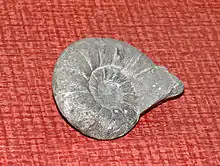Spitidiscus
Spitidiscus is a genus of ammonites placed in the family Holcodiscidae.[1]
| Spitidiscus | |
|---|---|
 | |
| Fossil shell of Spitidiscus species from Alpes-de-Haute-Provence, on display at Galerie de paléontologie et d'anatomie comparée in Paris | |
| Scientific classification | |
| Kingdom: | |
| Phylum: | |
| Class: | |
| Order: | |
| Family: | |
| Genus: | Spitidiscus Kilian, 1910 |
Species
List of species within Spitidiscus:[2]
- S. hugii
- S. kilapiae Rawson and Aguirre-Urreta, 2012 - Argentina
- S. oregonensis Imlay, 1960 - Oregon
- S. riccardii Leanza, and Wiedmann, 1992 - Argentina
- S. rotulia - England
- S. simitiensis Haas, 1960 - Colombia
- S. vandeckii (d'Orbigny, 1847)
Description
Member species have a rather evolute shell in which the whorl section is more or less circular, venter broadly rounded and dorsum fairly deeply impressed. Close, fine low, single or rarely branching ribs are interspersed by frequent straight or slightly sinuous, moderately deep but wide constrictions. The type species S. rotulia is from the Hauterivian of England.
Biostratigraphic significance
The first appearance of the species Spitidiscus hugii or Spitidiscus vandeckii are proposed to be the marker for the beginning of the Barremian.[3]
Distribution
Spitidiscus has been found in:[2]
- Agrio Formation, Argentina
- Magdalena Valley, Simití and Cáqueza, Colombia
- Kaliste Formation, Czech Republic
- France
- Gagra, Georgia, Caucasus
- Maiolica Formation, Italy
- Subbetics, Spain
- Foggy Creek, Oregon
- Bulgaria
- Portugal
- Russia
- Morocco
- Mexico
References
- Sepkoski, Jack Sepkoski's Online Genus Database – Cephalopoda
- Spitidiscus at Fossilworks.org
- "GSSP Table - Mesozoic Era". Geologic Time Scale Foundation. Retrieved 15 January 2014.
Bibliography
- W.J. Arkell et al., (1957). Mesozoic Ammonoidea in Treatise on Invertebrate Paleontology, Part L, Ammonoidea. Geological Society of America and Univ Kansas Press.
This article is issued from Wikipedia. The text is licensed under Creative Commons - Attribution - Sharealike. Additional terms may apply for the media files.